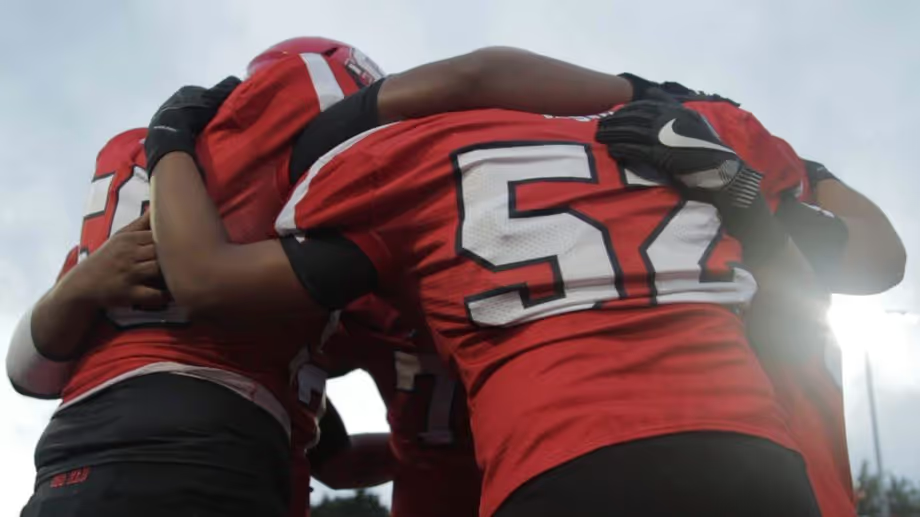
Transforming a Culture of Silence: Preventing Sexual Violence and Rape
When you witness an injustice, remaining silent or acting as a bystander is an active choice that is an impediment to justice. Speaking out and taking action are the counterpoints. The modern Civil Rights Movement would not have had the impact it did without thousands of individuals who spoke out and acted nonviolently to gain equal treatment under the law. More recently, the #MeToo movement’s power stems from individuals choosing to name and hold accountable those who perpetrate sexual harassment and violence. In both examples, the key factor in overcoming oppression and exploitation is breaking silence in the face of injustice.
In this lesson students will have the opportunity to examine the consequences of remaining silent specifically in relation to sexual violence and rape. Classrooms will watch curated segments from the acclaimed documentary Roll Red Roll, analyze in small groups a variety of perspectives involved in the case and identify moments when silence could have been broken. Students will then look at individuals who did intervene as model upstanders and reflect by writing proactive and prosocial steps they can each take to prevent, intervene, inform others and work toward ending sexual violence and rape culture.
Important Note to Educators
Roll Red Roll is a film about a sexual assault that occurred and can be difficult to watch and talk about, regardless of whether you or someone you know has been affected by violence. The film and lesson also include explicit language. Bringing these elements into a classroom conversation and sharing and processing this information requires a strong culture of respect and trust.
To prepare yourself and your students for this lesson:
● Read through the Discussion Guide for Roll Red Roll and consider integrating the Key Themes for Discussion and the related questions from the discussion guide into this POV lesson.
● Watch all the film clips suggested for this lesson prior to screening them in your classroom.
● Review the Resources section of this lesson and familiarize yourself with the recommended organizations and materials from the Discussion Guide for Roll Red Roll.
● Refer to and/or print and distribute the Important Terminology sheet at the end of this lesson and use it as a reference for yourself and your students. These terms and definitions can provide language for the class to use when discussing the film and the topics covered.
This lesson also offers two days of engagement, depending upon the grade level and preparedness of your students.
➔ Lesson: Students will view Clips 1 through 3, discuss a variety of perspectives and complete a reflective writing exercise.
➔ Extended Learning: Students will view Clips 4 and 5, discuss the choice of complicity by many peers and critically examine how technology added to the violation by bringing the crime to the “public square” of social media. If incorporating day two film segments, please pay particular attention to who is in your classroom.
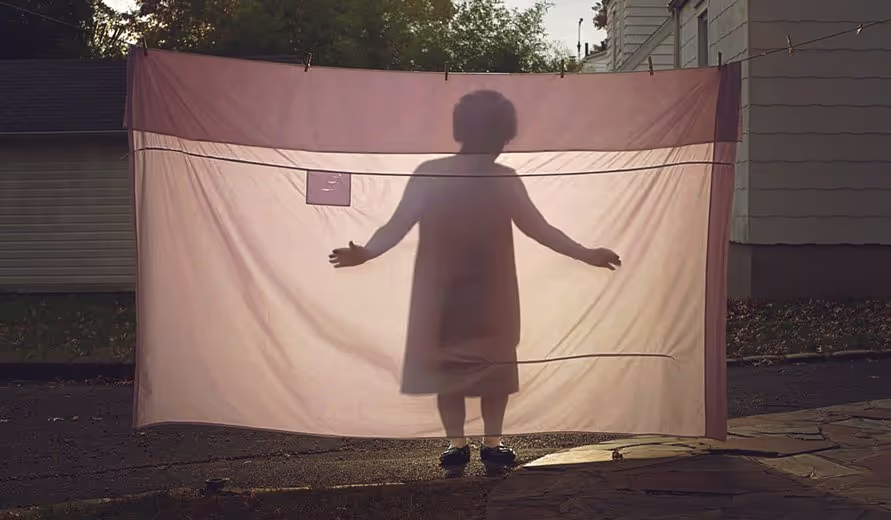
Reconstructing a Culture from Artifacts Left Behind
OVERVIEW
“Archaeology is the study of past cultures through the material (physical) remains people left behind.” (archaeological.org) Artifacts uncovered by archaeologists inform the narratives of history studied by every student in today’s schools. This lesson invites students to wonder about how scientists travel the path from a random item left behind to conclusions about how people lived or what they believed. Using the film 306 Hollywood as a model, students will be asked to create “catalogs” of “artifacts” representing their own lives or communities.
OBJECTIVES
In this lesson, students will:
- Explore how archaeologists make inferences about societies from the artifacts left behind
- Examine what the “artifacts” in our own homes say about our current society
- Create a representation of self by creating a catalog of personal artifacts
GRADE LEVELS: 10-12
SUBJECT AREAS
Archaeology
Art
History
Research Skills
U.S. History (post-WWII)
English/Language Arts
MATERIALS:
Film clips from 306 Hollywood and a way to screen them
[Optional]: Screen grabs of the catalogs (for use in class only)
ESTIMATED TIME NEEDED:
2 full class periods with homework in between
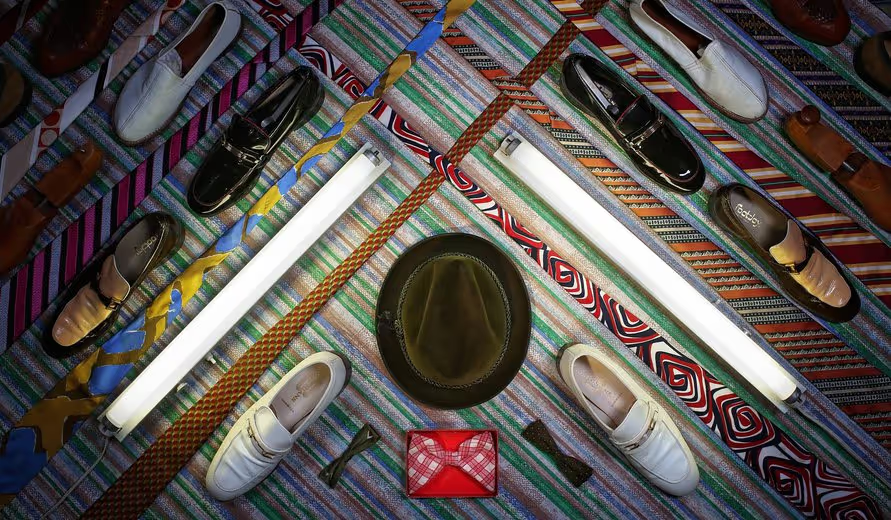
306 Hollywood: Discussion Guide
We are siblings who for years have aspired to make feature documentaries that reveal the myths and magic of everyday life. Towards this end, we set off to create 306 Hollywood, using humor, fantasy, and drama to transform the story of an old lady into an epic tale of what remains after life ends.
Before our grandmother Annette died, our intention was to make a candid and humorous film from the perspective of old age (“Getting old isn’t for sissies!” she always said). This project was based on 10 years of interviews we filmed with her. However, when we returned to Annette’s house after her funeral, we were faced with the grim reality of having to sell the house and throw out all of her possessions. That is when another, more complex, story emerged.
It is easy to take a house for granted. Domestic space is often overlooked, underestimated and left out of the mainstream record. Yet here was a space where our family had lived for 70 years. The thousands of objects that remained revealed layers of history—personal, social, and cultural. “A house is a universe,” physicist Alan Lightman declares in one interview. We believe this wholeheartedly, that our sense of time, identity and relationships are all connected to the home.
We are interested in rethinking the documentary form and are inspired by fairy tales, myths and magical realism. Fairy tales have been used for thousands of years to articulate our deepest fears and ease life transitions. We also believe that real life stories should be as entertaining and accessible as narrative films. Our cinematic language springs from this tradition and uses a technique called “normalized magic” where the day-to-day is collapsed with the wondrous. 306 Hollywood uses magical interventions to open the story to greater possibilities, to express the film’s themes of the visceral experience of grief and the psychological nature of memory, and to plumb the psychological truths that escape our everyday language.
We aim to transform the ordinary into the extraordinary. Our background is in the visual arts and we apply this sensibility to every one of our images. We crafted dozens of installations from Annette’s possessions; built a scale model of the house; turned our grandfather’s office into a mythical kingdom; and the last scene shows the entire house covered in the clothing of everyone who lived at 306 Hollywood.
— Elan and Jonathan Bogarín
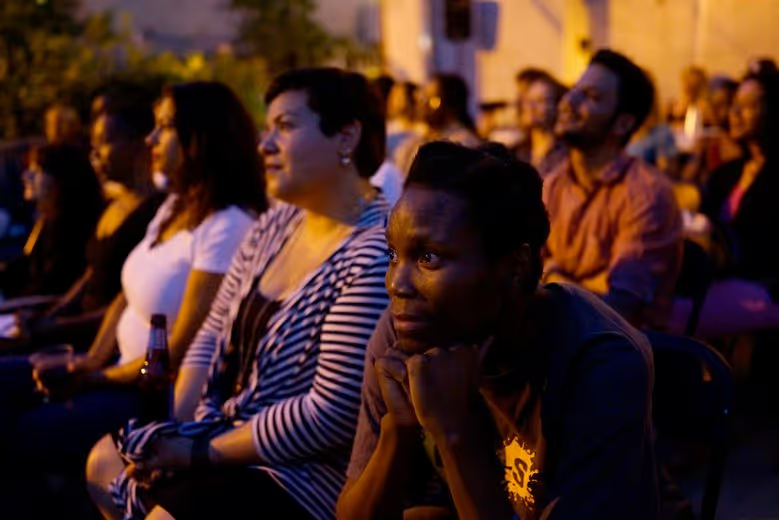
Step-by-Step Guide to Hosting a POV Screening
POV films showcase documentary film as an art form and can also be used to present information, get people interested in taking action on an issue, provide opportunities for people from different groups or perspectives to exchange views and create space for reflection. Refer to the event planning tips below to help you create a meaningful, high-impact event.
Step 1:
Determine your objectives.
POV film screenings can be tailored to your organization’s specific goals. Ask yourself:
Have I defined my goals?
Set realistic objectives with your partners by thinking about some basic questions: What do you want to happen as a result of your event? Who is your target audience? Keep in mind that some goals are easier to accomplish than others. For example, expanding a person’s knowledge is easier than changing his or her beliefs and behaviors. Establishing clear objectives will make it easier to decide how to structure the event (whether as a single meeting or an ongoing project, for example), target publicity and evaluate results.
Does the way I am planning to structure the event fit my objectives?
Do you need an outside facilitator, translator or sign language interpreter? If your objective is to share information, are there local experts on the topic who should participate in a panel discussion? How large an audience do you want? Large groups are appropriate for information exchanges, while small groups allow for more intensive dialogue.
Have I arranged to involve all stakeholders?
Think about contacting other community organizations, public officials or experts who might be good speakers. If your group is planning to take action that will affect people other than those present, it is especially important to give voice to those not in the room and ensure that people are allowed to speak for themselves. Ask stakeholders to identify their objectives and determine to what extent they can be involved.
Step 2:
Decide on a date, time and location.
Start planning your event at least one month in advance of the scheduled screening to ensure timely delivery of the film and adequate time for event promotion.
Your location should:
Be reserved for the duration of the film, if not longer
Be large enough to accommodate all attendees
Have proper A/V equipment: POV provides a copy of the film on DVD.
Possible event goals include:
Raising awareness of important issues that affect your community and the world
Encouraging dialogue around these issues forming new organizational alliances and partnerships
Making new contacts with the media and becoming a resource to be consulted
Recruiting new members through increased visibility
Enhancing your educational curriculum for students, staff and/or volunteers
Studying the art of documentary
Please note that goals may not include specific calls to action around legislation unless both sides are represented.
Step 3:
Sign up to host an event.
Join the POV Community Network:
- Check your inbox for a link to confirm your email address. A member of our team will approve your registration within 1 business day.
- Activate your account: Check your inbox for an activation link and temporary password. • Request: Once approved, log in to your account and click "My Events" to register a screening.
Let us know if you have trouble registering or change any of your event plans by contacting us at events@pov.org
Ask Yourself:
If the group is large, are there plans to break into smaller groups? Or should attendance be limited?
Is the event being held in a space where all participants will feel comfortable?
Is the space wheelchair accessible? Is it in a part of town that’s easy to reach by various kinds of transportation? If you are bringing together different constituencies, is the space in neutral territory? Does the physical configuration allow for the kind of discussion you hope to have?
Will the way that the room is set up help you meet your goals?
Is the room comfortable? Will everyone be able to see the screen easily and hear the film? If you intend to have a discussion, will people be able to see one another? Are there spaces appropriate for small breakout groups?
Have I scheduled time to plan for action?
Planning next steps can help people leave the room feeling energized and optimistic, even if the discussion has been difficult. Action steps are especially important for people who already have a good deal of experience talking about the issues on the table. For those who are new to the issues, just engaging in public discussion serves as an action step.
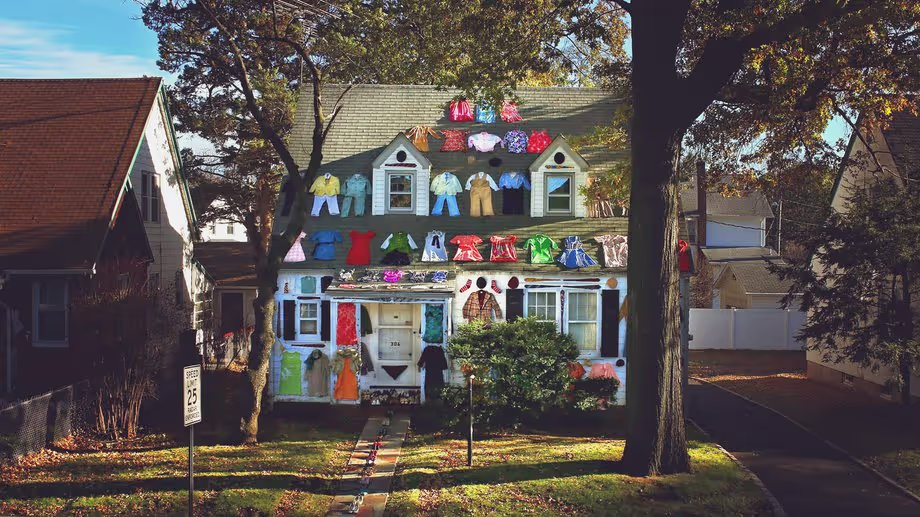
306 Hollywood Delve Deeper Reading List
Cooper, Anderson and Gloria Vanderbilt.The Rainbow Comes and Goes.Harper, 2016.
Anderson Cooper was busy with his career as a journalist when his mother, Gloria Vanderbilt, suffered her first serious illness at the age of ninety-one. After that experience, he decided to spend more quality time with her. This book follows a year-long conversation between mother and son discussing family history, personal tragedies and triumphs.
Heti, Sheila, Heidi Julavits and Leanne Shapton.Women in Clothes.Blue Rider Press, 2014.
A conversation among hundreds of women of all nationalities— famous, anonymous, religious, secular, married, single, young, old—on the subject of clothing, and how the garments we put on every day define and shape our lives.
Knisley, Lucy.Displacement: A Travelogue.Fantagraphics Books, 2015.
Displacementis Lucy Knisley’s graphic memoir of her experiences traveling with her aging grandparents on a cruise. Knisley explores her frustrations and fears while taking care of her grandparents and coming to terms with their mortality. The graphic novel looks at her family history, using her grandfather’s WWII memoir as a guide.
Lightman, Alan.Screening Room: A Memoir of the South.Pantheon Books, 2015.
Alan Lightman's grandfather, M.A. Lightman, was the family's undisputed patriarch. It was his movie theater empire that catapulted the Lightmans, a Hungarian Jewish immigrant family, to prominence in the South; his triumphs both galvanized and paralyzed his descendants. In this evocative personal history, the author chronicles his return to Memphis and the stifling home he was so eager to flee forty years earlier. As aging uncles and aunts retell old stories, Alan finds himself reconsidering long-held beliefs about his larger-than-life grandfather and his quiet, inscrutable father.
Shapiro, Bill and Naomi Wax.What We Keep: 150 People Share the One Object that Brings Them Joy, Magic, and Meaning.Running Press Adult, 2018.
Best-selling author and former editor-in-chief of LIFE magazine, Bill Shapiro shares the stories of 150 objects that are each deeply personal to their owners. The interviews range from renowned authors to everyday individuals. The stories are paired with photographs of the object and the interviewee.
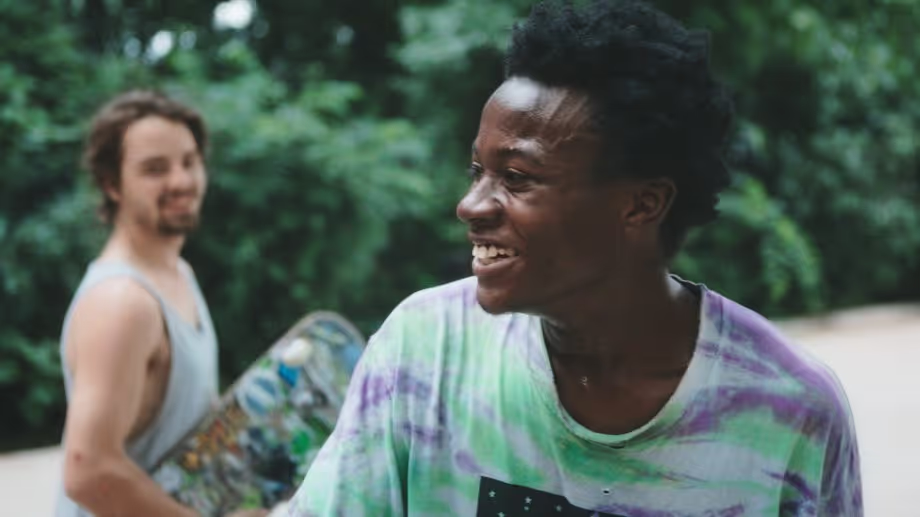
Minding the Gap: Discussion Guide
Minding the Gap started as a series of interviews on a road trip and snowballed into a confrontational saga of everything I couldn’t make sense of as a child.
I was 8 years old when my single mother took a job in Rockford, Illinois, a crumbling factory city two hours west of Chicago. She remarried a physically and mentally abusive man, had a child with him and then remained with him for 17 years. Because of his explosive, often unpredictable violence, I perceived the world as lacking causality: you could do the right thing or the wrong thing, but either way things might not go well for you. After I started skateboarding at age 13, through many bruises, broken bones and hard-earned tricks, I gradually regained a sense of control over my pain. Most importantly, I found myself much happier with a group of outcasts in the streets than at home. We spent countless hours together, making our own version of a family.
In my late teens and early twenties, I was struck by loss. I’d permanently escaped my home to move to Chicago, and I wanted to know why so many of my peers were falling prey to drug addictions, jail sentences or worse. I was still filming skate videos for fun—driving solo around the country and couch-surfing with other skateboarding friends I’d met over the years. Eventually I began interviewing skateboarders: What does skateboarding feel like? Who do you love more, your mom or your dad? Who taught you the feeling of hate? These conversations often turned into impromptu therapy sessions, intimate spaces for catharsis and realizations.
I discovered a pattern of absent, distant and abusive father-figures—something that affected mental health, relationships and parenting styles. A little more than one year into the project, I returned to Rockford, where I sat with a charming, goofy 16-year-old named Keire in his mother’s attic and asked him about his father. He’d never talked about their relationship before and was fidgeting with the sleeves of his sweater. When he told me about his abusive father, I felt my chest tighten with anxiety. “Did you cry?” I asked. “Wouldn’t you?” he shot back. “I did cry,” I said. We sat in silence, neither of us daring to attempt a joke.
For the next four years, I returned to Rockford to continue following Keire, as well as the ad-hoc leader of the Rockford skateboarding community, a charismatic 23-year-old named Zack who was about to become a father himself. After partnering with Kartemquin Films, I wanted to explore the connected themes of skateboarding and violence in the home through a character-driven approach. I took on a more cinema vérité style, drawing inspiration from the films that resonated with me in my adolescence: Gummo, Waking Life, Kids, Slacker—stories that captivated me with their representations of growing up in a chaotic, uncertain world. I could relate to them, and through them I could also find hope.
As I began assembling rough cuts and holding feedback screenings, people were surprised at how close I was to the themes and community of the film. With their encouragement, I began participating in the film more. À la Sherman’s March, the cameraperson was cast as a character. But then everything changed when (spoiler alert) the mother of Zack’s child told me Zack had been battering her. The heart of the film, which had been exploring how skateboarders deal with masculinity and child abuse, suddenly became much more murky with immediate and personal ramifications; I was forced to become an active participant in the story, eventually interviewing my estranged mother and half-brother about my stepfather and revisiting old footage to find a way to tell my own story.
People are often surprised that I didn’t know Keire and only briefly knew Zack growing up but that we were still able to have candid and vulnerable moments with each other when I came back to Rockford. In the course of making the film, I realized that Zack, Keire and I were all harboring toxic experiences buried under the weight of years of societal and personal repression, and we all chose our own ways of dealing with that pressure. The film has given me a sense of clarity about myself and shown me that, while there’s no one-size-fits-all solution, some ways of coping aren’t sustainable.
What’s clear from doing this project is that violence and its sprawling web of effects are perpetuated in large part because these issues remain behind closed doors, both literally and figuratively. My hope is that the characters who open doors in Minding the Gap will inspire young people struggling with something similar—inspire them to see that they can survive their situations, live to tell their stories and create lives of causality for themselves.
— Bing Liu, Director
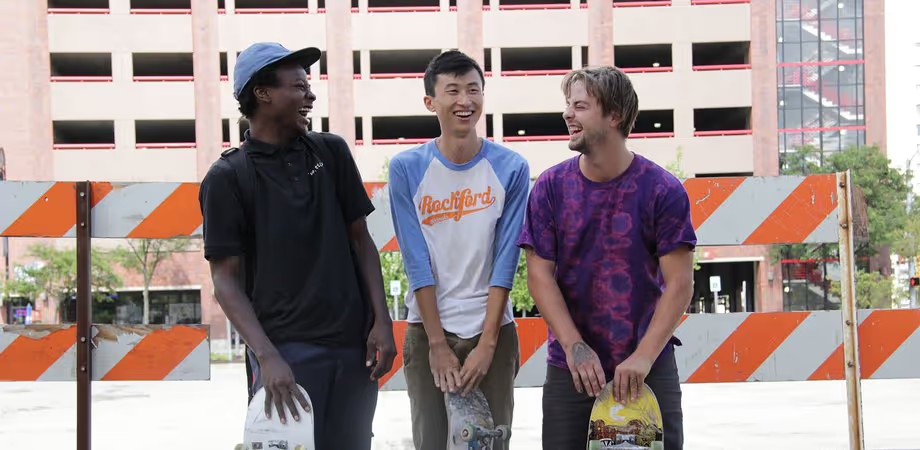
Minding the Gap: Educator Resource
Minding the Gap is a coming of age film by Bing Liu. Starting in high school, Bing begins to make skate videos. What starts as a hobby ends up as a profound exploration of issues that is likely to resonate deeply with students.
The diverse group of participants in the film – Bing, Keire, Zack, and Nina – see and feel the often jarring challenges of life in a small, declining Rust Belt city. Collectively, they experience family violence, substance abuse, economic insecurity, racism, and teen pregnancy, along with the typical struggles of identity formation as teens become adults. To cope, they skate — regulating the speed at which they move through life, attacking obstacles and flipping over platforms, sometimes unsuccessfully. The risks they take are sometimes rewarded and sometimes the source of pain. But they persevere.

Minding the Gap Delve Deeper Reading List
Thompson, Neal.Kickflip Boys: A Memoir of Freedom, Rebellion, and the Chaos of Fatherhood. Ecco, 2018.
What makes a good father, and what makes one a failure? Does less-is-more parenting inspire independence and strength, or does it encourage defiance and trouble? Kickflip Boys is the story of a father’s struggle to understand his willful skateboarder sons, challengers of authority and convention, to accept his role as a vulnerable “skate dad,” and to confront his fears that the boys are destined for an unconventional and potentially fraught future.
Cumming, Alan.Not My Father's Son: A Memoir. Dey Street Books, 2014.
When television producers approached Alan Cumming to appear on a popular celebrity genealogy show, he hoped to solve the mystery of his maternal grandfather's disappearance that had long cast a shadow over his family. But this was not the only mystery laid before Alan. Alan grew up in the grip of a man who held his family hostage, someone who meted out violence with a frightening ease, who waged a silent war with himself that sometimes spilled over onto everyone around him.
McClelland, Edward.Nothin' But Blue Skies: The Heyday, Hard Times, and Hopes of America's Industrial Heartland. Bloomsbury Press, 2013.
Nothin' but Blue Skies tells the story of how the country's industrial heartland grew, boomed, bottomed, and hopes to be reborn. Through a propulsive blend of storytelling and reportage, celebrated writer Edward McClelland delivers the rise, fall, and revival of the Rust Belt and its people.
Hooks, Bell.All About Love: New Visions.HarperCollins, 2000.
As bell hooks uses her incisive mind and razor-sharp pen to explore the question “What is love?” her answers strike at both the mind and heart. In thirteen concise chapters, hooks examines her own search for emotional connection and society’s failure to provide a model for learning to love. Razing the cultural paradigm that the ideal love is infused with sex and desire, she provides a new path to love that is sacred, redemptive, and healing for individuals and for a nation.
Coates, Ta-Nehisi.Between the World and Me.Penguin Random House, 2015.
In a profound work that pivots from the biggest questions about American history and ideals to the most intimate concerns of a father for his son, Ta-Nehisi Coates offers a powerful new framework for understanding our nation’s history and current crisis. Americans have built an empire on the idea of “race,” a falsehood that damages us all but falls most heavily on the bodies of black women and men—bodies exploited through slavery and segregation, and, today, threatened, locked up, and murdered out of all proportion. What is it like to inhabit a black body and find a way to live within it? And how can we all honestly reckon with this fraught history and free ourselves from its burden?
Novak, Brandon and Joe Frantz.Dreamseller: An Addiction Memoir.Citadel, 2009.
At seven, Brandon was a skateboard prodigy. By the time he was fourteen, he was living the dream. Discovered by skate legends Bucky Lasek and Tony Hawk. Touring the U.S. with the elite Powell-Peralta team. Signing autographs and appearing in films and magazines. Brandon had it all. Then he got hooked on heroin. Soon the up-and-coming star was living a down-and-out life in a garage, begging for change, and hustling to score his next fix. He stole from his family and friends. He pushed the fantasy that everything was okay, that he was going to rehab, getting help, and getting better. But it was all a lie. This is the story of an addict—a dreamseller who stopped believing the lies he was selling and started believing in himself.
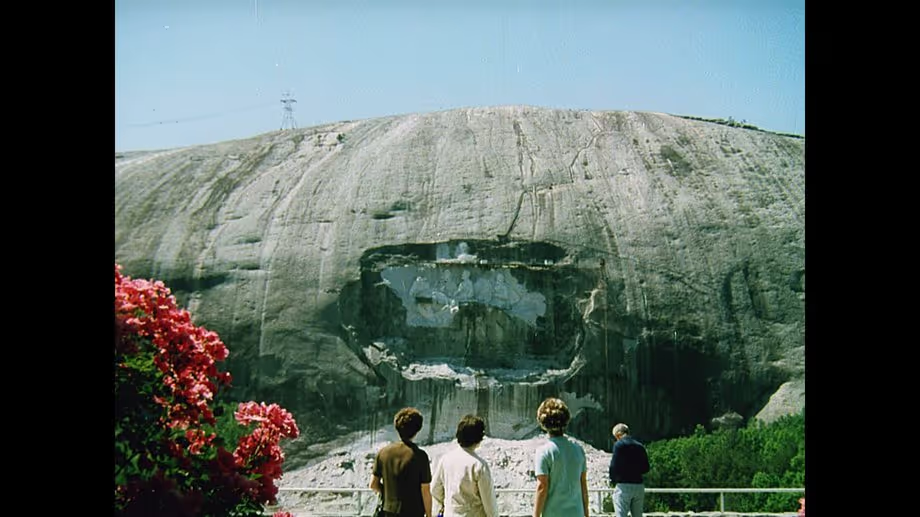
Stone Mountain and Historical Memory: Who Defines the Past?
Some 300 million years ago, an eruption of magma produced the massive granite rock that is known today as Stone Mountain in Georgia. Humans first stepped foot on this remarkable landmark around 4,000 B.C.E. and have continued to gather at its summit for more than six millennia. In 1915, one such gathering took place that would alter Stone Mountain in the eyes of Georgians and the world.
At midnight on November 25, 1915, a dozen white supremacists climbed to the top of Stone Mountain and burned a cross, inspired by the D.W. Griffith’s propaganda film The Birth of a Nation. This marked the revival of the Ku Klux Klan, a violent terror group that grew to a membership of more than 4 million in 10 years, and cemented Stone Mountain’s link with that group. The brothers who owned the mountain, the 85 year-old president of the Atlanta United Daughters of the Confederacy and the Klan-sympathizing sculptor Gutzon Borglum (who would go on to carve Mount Rushmore) then launched their plan to etch three Confederate generals into the mountain’s façade. In 1972 the carving was completed, transforming Stone Mountain into the world’s largest Confederate memorial and celebration of American white supremacy.
“Stone Mountain allows for a full century’s worth of reckoning with the motivations and politics behind these celebrations of the Confederacy and the Lost Cause narrative,” says Sierra Pettengill, director of the film, Graven Image. “In my film, a voiceover from a 1972 Stone Mountain promotional film says, ‘Remember how it used to be? It’s still that way for you to enjoy at Stone Mountain Park.’ I want this film to make us remember how it actually used to be.”
Recent conflicts over resurgent white nationalism and its links to Confederate monuments in public spaces have prompted conversations about the role of history in our national identity. These debates are an opportunity to critically examine our historical memory and to reevaluate our cultural symbols, like monuments, as our nation’s values and priorities evolve.
In this lesson, students use the short film Graven Image to explore the meaning and function of monuments, analyze the role collective historical memory plays in shaping our identities, and engage with monuments in their own communities to better understand the power dynamics that shape public spaces.

Media Literacy Questions for Analyzing POV Films
Because everyone interprets media through the lens of his or her own experience, media literacy analysis is about rich readings rather than specific “right” answers.
These suggested questions are starting points for that type of analysis. They are designed for diverse films and audiences; choose the ones that best meet the needs of your situation. To encourage deeper readings, try using follow-up questions such as, “How do you know?”; “How could you find out?”; “What evidence from the film backs up your answer?”; “What else do you notice?”; or “What else do you want to know?”
Based on NAMLE’s Core Principles of Media Literacy Education in the United States, April 2007 –www.NAMLE.NET/core-principles– Adapted by Faith Rogow, Ph.D.
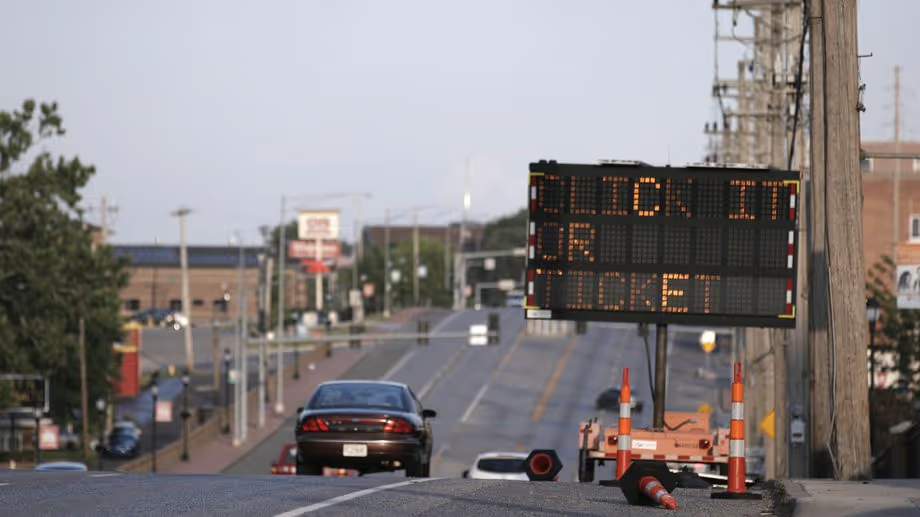
The Poverty to Prison Pipeline
Across racially segregated St. Louis County, Missouri, thousands of people have been routinely sent to jail because they cannot pay local court fines and fees. The vast majority of those fined are poor and black. In Ferguson and the surrounding municipalities, where police shooting victim Michael Brown was killed, a practice with historical antecedents has become systematic: jailing the impoverished when they are unable to pay fines and fees. In A Debtors’ Prison, Samantha Jenkins and Meredith Walker recount their unfolding court cases in St. Louis County, describing the matrix of controls that has incarcerated them repeatedly for being poor.
Through the stories in A Debtors’ Prison, students will understand how aggressive policing, court fees and monetary sentencing have created a cycle of debt and incarceration in poor communities across the United States. They will compare the circumstances in Missouri municipal courts to the policies and procedures of their local juvenile justice systems and write persuasive essays in the form of letters to their local representatives.

Dark Money Delve Deeper Reading List
Mayer, Jane.Dark Money: The Hidden History of the Billionaires Behind the Rise of the Radical Right. Doubleday, 2016.
Why is America living in an age of profound and widening economic inequality? Why have even modest attempts to address climate change been defeated again and again? Why do hedge-fund billionaires pay a far lower tax rate than middle-class workers? In a riveting and indelible feat of reporting, Jane Mayer illuminates the history of an elite cadre of plutocrats—headed by the Kochs, the Scaifes, the Olins, and the Bradleys—who have bankrolled a systematic plan to fundamentally alter the American political system.
Teachout, Zephyr.Corruption in America: From Benjamin Franklin’s Snuff Box to Citizens United. Harvard University Press, 2014.
In 2010, one of the most consequential Court decisions in American political history gave wealthy corporations the right to spend unlimited money to influence elections. Justice Anthony Kennedy’s majority opinion treated corruption as nothing more than explicit bribery, a narrow conception later echoed by Chief Justice Roberts in deciding McCutcheon v. FEC in 2014. With unlimited spending transforming American politics for the worse, warns Zephyr Teachout, Citizens Unitedand McCutcheon were not just bad law but bad history.
Collins, Ronald K.L. When Money Speaks: The McCutcheon Decision, Campaign Finance Laws, and the First Amendment.Top Five Books, 2014.
On April 2, 2014, the U.S. Supreme Court struck down aggregate limits on how much money individuals could contribute to political candidates, parties, and committees. The McCutcheon v. FECdecision fundamentally changes how people (and corporations, thanks to Citizens United) can fund campaigns, opening the floodgates for millions of dollars in new spending, which had been curtailed by campaign finance laws going back to the early 1970s. When Money Speaks is the definitive—and the first—book to explain and dissect the Supreme Court’s controversial ruling in McCutcheon, including analysis of the tumultuous history of campaign finance law in the U.S. and the new legal and political repercussions likely to be felt from the Court’s decision.
Mutch, Robert E.Campaign Finance Reform: What Everybody Needs to Know.Oxford University Press, 2016.
In 2015, well over half of the money contributed to the presidential race came from roughly 350 families. The 100 biggest donors gave as much as 2 million small donors combined. Can we still say we live in a democracy if a few hundred rich families provide a disproportionate shares of campaign funds? Congress and the courts are divided on that question, with conservatives saying yes and liberals saying no. The debate is about the most fundamental of political questions: how we define democracy and how we want our democracy to work.
Shapiro, Bruce. Shaking the Foundations: 200 Years of Investigative Journalism in America. Thunder’s Mouth Press/Nation Books, 2003.
Great investigative journalism is present-tense literature: part detective story, part hellraising. This is the first anthology of its kind, bringing together outstanding (and often otherwise unavailable) practitioners of the muckraking tradition, from the Revolutionary era to the present day. Ranging from mainstream figures like Woodward and Bernstein to legendary iconoclasts such as I. F. Stone and Ida B. Wells-Barnett, the dispatches in this collection combine the thrill of the chase after facts with a burning sense of outrage.
Smith, Bradley A. Unfree Speech: The Folly of Campaign Finance Reform. Princeton University Press, 2001.
At a time when campaign finance reform is widely viewed as synonymous with cleaning up Washington and promoting political equality, Bradley Smith, a nationally recognized expert on campaign finance reform, argues that all restriction on campaign giving should be eliminated. In Unfree Speech, he presents a bold, convincing argument for the repeal of laws that regulate political spending and contributions, contending that they violate the right to free speech and ultimately diminish citizens’ power.
Broder, David S. Democracy Derailed: Initiative Campaigns and the Power of Money. Harcourt, 2000.
A new form of government is sweeping across America: the initiative process, available in half the states and hundreds of cities. Where once most state laws were passed by legislatures, now voters decide directly on such explosive issues as drugs, affirmative action, casino gambling, assisted suicide, and human rights. Ostensibly driven by public opinion, the initiative process is, in reality, manipulated by moneyed interests, often funded by out-of-state millionaires pursuing their own agendas. In this highly controversial book David Broder tells how this revolution came about.
